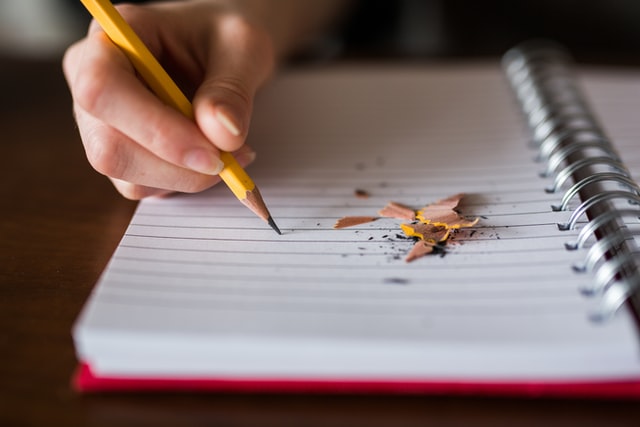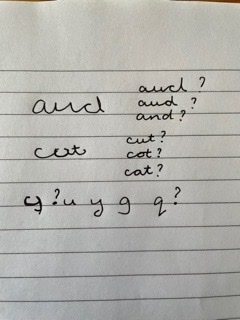Once children move beyond the infant stage, there can be a very broad spectrum of handwriting abilities. On the one hand there are 7 year olds with virtually perfect script. On the other hand, there are those whose handwriting remains large, inconsistent and – at times – illegible as they move through primary and into secondary school. As children get older, it can become frustrating and seem childish to have to work on their handwriting. So here are some handwriting tips for slightly older children who continue to struggle with handwriting…

Why?
Usually, handwriting problems fall into one or more of these areas:
- letter formation – actually making the correct letter shape
- sizing – tall letters tall, short letters short etc
- spaces between words
- pencil pressure
- copying accuracy
- line-alignment
What to do to help
- Fine motor skill exercises – anything which gets their fingers moving in a detailed way such as cutting, using a screwdriver, sorting small items, sewing, manipulating clay etc. If they prefer, you could set up a list or box of activities and call it a hand exercise programme. This can be helpful if they are more mature or actively want to improve their skills. There are several ideas online so that you can pick those that suit your child.
- Upper body strength – arms, shoulders, core. It surprised me when I learnt some years ago about the importance of upper body strength and posture regarding handwriting. So if you feel this is an area which could be strengthened, encourage sports, climbing, swimming and exercises such as wheelbarrow, crawling and ‘crab’ (I always think of this as an upside down crawl) games.
- Posture – sitting at a desk with arms at right angles to the desk top is really helpful. Make sure their feet touch the floor – it helps steady and root their whole body. I spent much time in school putting boxes underneath children’s feet – dangling feet do not help handwriting! Encourage them to use two hands – one hand writes whilst the other steadies the paper. It is often helpful to angle the paper slightly rather than have it square on to the body.
- Use lined paper or a line guide. (You can make one by ruling out an A4 sheet with a thick black marker. Then place it underneath a plain writing sheet). We often ask infants in school to put a finger between each word to physically create a space between words. A younger child can be encouraged to continue to do this. Older children may feel this is beneath them and it could damage their confidence. Perhaps try to get them to lift their pen slightly between words, place a dot as they start a new word or whisper the word ‘space’. These are temporary practice ideas not permanent solutions!
Hints for practising handwriting
Depending on the age and inclination of your child, you could set up some regular handwriting tasks. In these, you might model a set of letters (perhaps all those ‘tall’ letters to start with) and let them copy them. Or you may choose to focus on some common words to ensure cursive script and help their muscle memory remember that ‘and’ needs to have a good tall ‘d’ at the end.
If you feel copying is an issue, consider reading aloud something for them to write so that their focus is on their page and their handwriting. See what happens when you let them keep their eyes on the page…
Alternatively you might set them a short task where you explain that handwriting is really important. A very short thank you note for example. If this is the case, try to ensure that they are not thinking about other aspects of writing as well (ie the content of what to write, punctuation, spelling etc). Try to ensure their brain is free to focus on the handwriting.
Whatever you do, give them breaks – handwriting can be tiring mentally and physically.
Handwriting tips – equipment
A good pencil doesn’t cost much so experiment with different types of pencils – in particular consider triangular style pencils or ones with slight grips to them, such as this Stabilo range. There are also a number of grips on the market which can help if you feel that your child is gripping the pencil too tightly or softly; or that they struggle to keep their fingers in a good position around the pen or pencil. It is worth seeing what they find comfortable or useful and it may be worth approaching your school to see if they can try some out with them first. These ultra grips are commonly used but I also like this type of claw grip.
Handwriting hints for the longer term
Keep it positive. A lack of confidence in itself can hinder handwriting. Anxiety can lead to excessive pressure for example, or the feeling that they need to cover up their mistakes. Praise them for effort and for attempting to improve their handwriting.
Try to explain why handwriting is important. If the ‘h’ look like an ‘n’ and the ‘o’ looks like a ‘u’ it can lead to real confusion for the reader. It could mean that a teacher cannot read their brilliant ideas, they might get penalised unfairly for spellings or their friends may misunderstand them when they write a card or a note. If the child can be encouraged to see legible handwriting as important, it will give them motivation to address it.

Consider seeking professional help, particularly if you think that there are a range of issues contributing. Talk to your child’s teacher and ask them to give you an honest assessment. Perhaps look at a school book together and consider a joint strategy. If you suspect copying could be contributing to poor handwriting, do explore this with the teacher. A child who is constantly looking at the board, but never at their writing as they copy, is likely to find it hard.
Is it worth checking their eyesight? In the UK, there are free NHS eye tests available for children. Just check that the optician is offering this service when you book.
Consider asking for the assessment and input of an occupational therapist. You may be able to get a referral through your GP, particularly if you have other concerns about their everyday skills (eg using cutlery, dressing, organisation, co-ordination etc). Alternatively there are paediatric occupational therapists who can offer private consultations and make recommendations. (Please contact me for recommendations in the Surrey area).
Finally, remember that for some children, dysgraphia remains a real issue. Fortunately, technology will more than likely help our children as they get older. However, as with many difficulties, primary and the start of secondary school is a time when these issues come to the fore. However, for other children, handwriting can be radically improved with some fairly simple steps. If you would like to discuss this issue further, please take a look at my ‘work with me‘ pages or contact me here. Good luck!